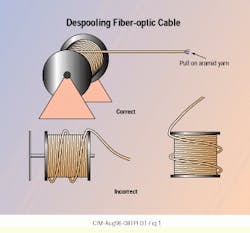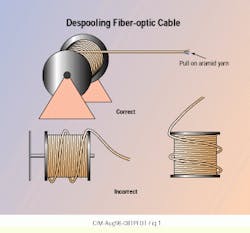Thomas Dooley, Fiber Specialists Inc.
Jerald Rounds, Arizona State University
Problem
The basic approach to pulling fiber-optic cable and copper cable is similar; however, optical fiber has a few idiosyncrasies. The glass fiber within the cable is fragile and, although the cable has been designed to protect the fiber, it can be damaged more easily than a copper wire. The most common damage is a broken fiber, which is difficult to detect. But fibers can also be cracked from too much tension during cable pulling or despooling. The second most common problem is bending the fiber on too tight a radius.
Solution
During the cable-pulling step, always maintain the proper uniform pulling force (tensile stress) on the cable. In addition, although it is always important to maintain the minimum bend radius, it becomes more important under tensile loading because of the additional stress from pulling the cable.
Procedure
1) Before any pulling or installing, test the cable to eliminate disputes that may arise over responsibility for damaged cable.
2) Set up cable spool so the cable pays off the top.
3) To avoid twisting the cable, which stresses the fiber, reel cable off the spool; don`t spin it over the edge of the spool.
4) When unreeling the cable or applying tension to the cable, always use the strength member--never the fiber.
5) Do not pull on the outer jacket because this will elongate and momentarily stretch it. When the jacket returns to its normal state, the fiber and strength member may be compressed in the retraction of the jacket, which can cause macrobend attenuation in the cable.
6) Pull uniformly on the cable, maintaining the pulling force below the limit designated for the specific cable--usually 600 lbs. for outside-plant cable and 300 lbs. or less for other cables.
7) Do not jerk the cable because most fiber cannot handle high-impact loads.
8) When cable is under tensile load (while being pulled), maintain a bend radius of 20 cable diameters.
Note: In long-term static conditions, the recommended bend radius is 10 times the cable diameter. In addition, installations where cable is placed into a tray by hand may allow a tighter radius.
9) When using power equipment to pull outside-plant cable, always use tension-monitoring equipment or breakaway swivels.
10) Never use power equipment on inside optical-fiber cable because the allowable pulling force is too small.
Use innerduct to protect the fiber cable from damage by sharp corners or protrusions, such as where conduit enters pull boxes and cabinets.
This tip is excerpted and reproduced by permission from Fiber Optics Technician`s Manual, authored by Jim Hayes, president of Fotec Inc. (Medford, MA), and published by Delmar Publishers, Albany, NY (see "By the Book," July 1996, page 71). Chapter 15, "Fiber Optic Cable Pulling" was written by Thomas Dooley, Fiber Specialists Inc., and Jerald Rounds, Arizona State University, instructors for Fiber U, a fiber-optic training conference presented by Fotec, with input from Northern Lights Cable (North Bennington, VT).
The correct method of despooling fiber-optic cable (top) is to reel the cable off the spool, applying tension only to the strength member (aramid yarn). Never spin the cable over the edge of the spool (bottom).

